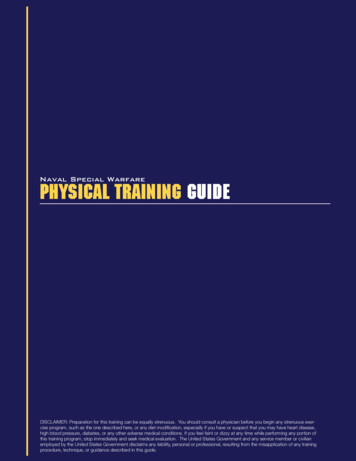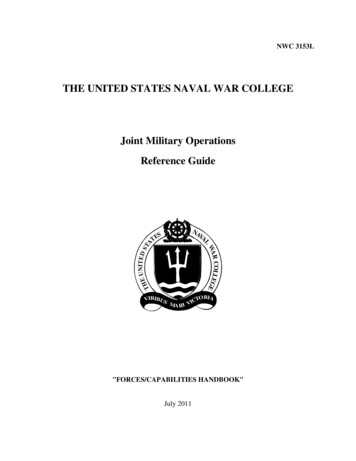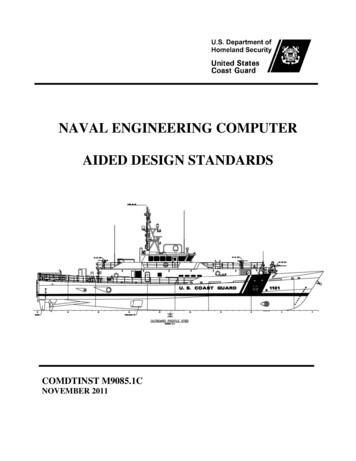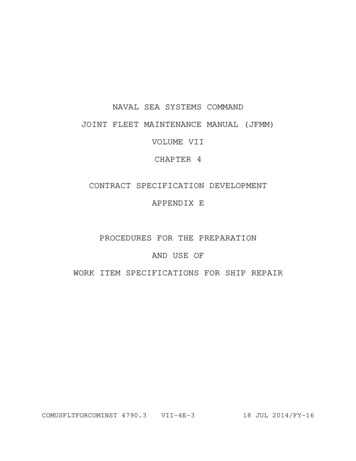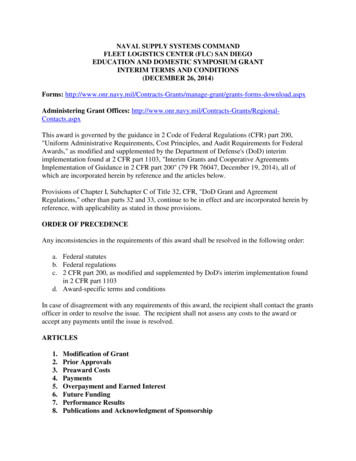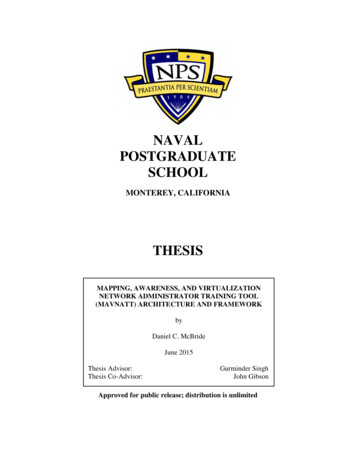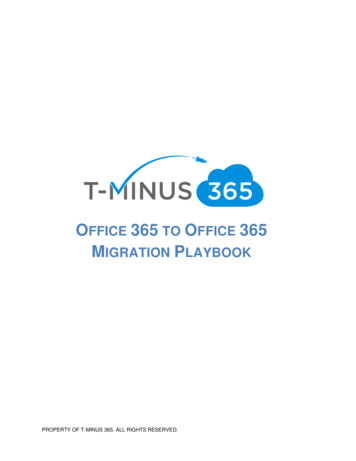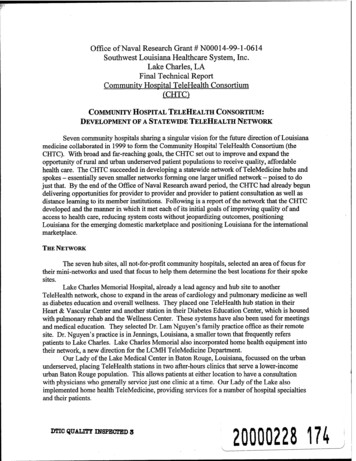
Transcription
Office of Naval Research Grant # N00014-99-1-0614Southwest Louisiana Healthcare System, Inc.Lake Charles, LAFinal Technical ReportCommunity Hospital TeleHealth Consortium(cmoCOMMUNITY HOSPITAL TELEHEALTH CONSORTIUM:DEVELOPMENT OF A STATEWIDE TELEHEALTH NETWORKSeven community hospitals sharing a singular vision for the future direction of Louisianamedicine collaborated in 1999 to form the Community Hospital TeleHealth Consortium (theCHTC). With broad and far-reaching goals, the CHTC set out to improve and expand theopportunity of rural and urban underserved patient populations to receive quality, affordablehealth care. The CHTC succeeded in developing a statewide network of TeleMedicine hubs andspokes - essentially seven smaller networks forming one larger unified network - poised to dojust that. By the end of the Office of Naval Research award period, the CHTC had already begundelivering opportunities for provider to provider and provider to patient consultation as well asdistance learning to its member institutions. Following is a report of the network that the CHTCdeveloped and the manner in which it met each of its initial goals of improving quality of andaccess to health care, reducing system costs without jeopardizing outcomes, positioningLouisiana for the emerging domestic marketplace and positioning Louisiana for the internationalmarketplace.THE NETWORKThe seven hub sites, all not-for-profit community hospitals, selected an area of focus fortheir mini-networks and used that focus to help them determine the best locations for their spokesites.Lake Charles Memorial Hospital, already a lead agency and hub site to anotherTeleHealth network, chose to expand in the areas of cardiology and pulmonary medicine as wellas diabetes education and overall Wellness. They placed one TeleHealth hub station in theirHeart & Vascular Center and another station in their Diabetes Education Center, which is housedwith pulmonary rehab and the Wellness Center. These systems have also been used for meetingsand medical education. They selected Dr. Lam Nguyen's family practice office as their remotesite. Dr. Nguyen's practice is in Jennings, Louisiana, a smaller town that frequently referspatients to Lake Charles. Lake Charles Memorial also incorporated home health equipment intotheir network, a new direction for the LCMH TeleMedicine Department.Our Lady of the Lake Medical Center in Baton Rouge, Louisiana, focussed on the urbanunderserved, placing TeleHealth stations in two after-hours clinics that serve a lower-incomeurban Baton Rouge population. This allows patients at either location to have a consultationwith physicians who generally service just one clinic at a time. Our Lady of the Lake alsoimplemented home health TeleMedicine, providing services for a number of hospital specialtiesand their patients.DTIC QUALITY INSPECTED 320000228 174
Office of Naval Research Grant # N00014-99-1-0614 - CHTC - Page 2 of 6Our Lady of Lourdes Medical Center in Lafayette, Louisiana, narrowed its efforts toeducation and meetings for 1999, with plans for expansion in the near future. They have oneTeleHealth station located in a hospital conference room well suited for group medical educationand administrative meetings.Slidell Memorial Hospital, like Our Lady of the Lake, divided its focus between homehealth and underserved TeleMedicine; however, Slidell Memorial placed its remote TeleHealthstation in a rural area: the Gaylord Family Medical Center in Bogalusa, Louisiana, with the hubstation in the SMH ER quiet room. In addition to serving home health and rural patients throughaccess to care, Slidell Memorial also plans to use this technology for medical training. Theyplaced a third TeleHealth system in their Training & Development Center.St. Francis Medical Center in Monroe, Louisiana, chose ophthalmology as its specialty.In an innovative move contrary to traditional TeleMedicine, St. Francis placed the remoteTeleHealth system in a hospital, Jackson Parish Hospital in Jonesboro, Louisiana. They placedhub systems in the offices of two ophthalmology practices in Monroe and West Monroe,Louisiana. As a rural hospital, Jackson Parish does not have access to ophthalmology specialistssuch as those in the Monroe area.Terrebonne General Medical Center in Houma, Louisiana, directed all of its attention tohome health, utilizing a variety of systems to best serve the needs of their rural, remote patientbase.Willis-Knighton Medical Center in Shreveport, Louisiana, focussed on infants. Theyplaced their remote TeleHealth station in the Minden Medical Center nursery in Minden,Louisiana, and their hub station in the NICU of their Willis-Knighton South campus. Infants atthe Minden nursery needing intensive care are referred to the Willis-Knighton South NICU; thisTeleHealth system allows provider to provider consultation as well as family to patient visitation.Willis-Knighton later decided to add home health to their network as well.DEVELOPING THE NETWORKDeveloping this statewide network took a lot more than just selecting sites, however. TheCHTC began by looking for the right TeleHealth equipment. To help in this process, LakeCharles Memorial hosted a two-day vendor demonstration event. A total of nine companies gavedemonstrations of 12 systems. From these, three vendors were selected. American TeleCareprovided home health equipment; VidiMedix provided PC TeleMedicine systems forvideoconferencing and store-and-forward consults; and Raytheon provided Tylink channelservice units and network integration.The home health systems utilized plain old telephone service (POTs) transmission, whichworks best for quick and easy installation in a patient's home. The American TeleCareequipment came in two varieties in addition to the hub station located in each home healthagency. Patient stations could be equipped either with just the camera and monitor needed forvideo and audio communication or with an additional stethoscope and blood pressure cuff. Thehub station, in addition to the camera and monitor, housed electronic chart software for storingpatient information. A total of 40 units were purchased: six base stations, two for Our Lady ofthe Lake and one each for Lake Charles Memorial, Slidell Memorial, Terrebonne General andWillis-Knighton; 12 video-only units, four for Our Lady of the Lake, three each for Lake CharlesMemorial and Slidell Memorial and two for Willis-Knighton; and 22 video plus stethoscope andblood pressure units, 10 for Terrebonne General, five for Our Lady of the Lake, three each for
Office of Naval Research Grant # N00014-99-1-0614 - CHTC - Page 3 of 6Lake Charles Memorial and Slidell Memorial and one for Willis-Knighton. Terrebonne Generallater purchased additional home health systems from Med-Ed-Tech, a total of three units. Allhome health systems were delivered by late summer.Because Lake Charles Memorial Hospital already had a TeleMedicine system in place,the VidiMedix equipment purchased worked with what they were already using. Lake CharlesMemorial was running video and audio signals over Tl lines, with mapping of the lines handledat the Lake Charles facility through a FlexServ system. Raytheon participated by providingTylink CSU/DSUs for each site along with the necessary network integration to make sure thatall sites were communicating over the Tl lines.VidiMedix had never worked with this type of FlexServ system in the past, so theirintegration took a bit of debugging. By the end, however, the CHTC had a working network inwhich any site, remote or hub, could connect with up to three other sites through a multi-pointcontrol unit. Installation and training on this equipment were completed in November. Inaddition to straight video and audio connections, sites with VidiMedix equipment are able toshare patient charts through Internet connections to a central server, housed at Lake CharlesMemorial. One provider can register a patient and enter chart information, then upload it to theInternet and send a request to another provider to offer a store-and-forward TeleMedicineexchange or interactive videoconference consultation. The consultant can then download all ofthe patient information from the server, participate in a videoconference if requested, makechanges and / or additions to chart information and re-upload the information to the server foruse by the referring provider. Additionally, during a videoconference, both sites can share animage, making alterations and pointing out items to one another through a whiteboard typesetting on the image software. Finally, the VidiMedix software also allows individual providersto send alert messages to one another to notify other providers of upcoming appointments orother events.VidiMedix offered three types of TeleHealth systems: hub stations, with a fixed camera;remote stations, with a movable camera to aid in viewing a patient; and education systems,without the unnecessary medical records software installed. Lake Charles Memorial and OurLady of Lourdes each purchased one hub and two remote stations; St. Francis purchased two huband one remote station; Our Lady of the Lake purchased one hub and one remote station; andSlidell Memorial and Willis-Knighton each purchased one of each type.This kind of statewide site to server connectivity allows providers to offer a great deal totheir patients and to one another. By sharing the same electronic chart, providers can be assuredthat they are always looking at the most current data. By sharing images in real time, providerscan be assured that they are discussing the same detail of a patient image. And by offering bothof these in conjunction with real time interactive videoconferencing, providers can find themethod of seeing and treating a patient best suited to the situation. All of these tools create anenvironment of improved patient care.IMPROVING QUALITY OF AND ACCESS TO HEALTH CAREThrough every bit of work done via the CHTC TeleMedicine network, the consortiummembers are improving quality of and access to health care. This comes in the form ofTeleHealth equipment in a patient's home, which directly improves access to care. It alsoappears as interactive and store-and-forward TeleMedicine consultations, which allow patientsaccess to specialists without the expense of time and cost of travel, improving both quality of and
Office of Naval Research Grant # N00014-99-1-0614 - CHTC - Page 4 of 6access to healthcare. Additionally, it comes in the form of opportunities for medical educationfor providers, which allow providers to stay abreast of the most current research anddevelopments in their fields without having to take time and resources away from their practices,again providing both improved quality of and access to healthcare. Finally, patients benefitindirectly from the use of the equipment for program and clinic development, other activities theCHTC performs via TeleMedicine.The ability for a patient to connect with a provider from the convenience of his or herown home equals improved access to health care. Our Lady of the Lake, Slidell Memorial andTerrebonne General have all done extensive work in the area of home health TeleMedicine,which offers patients nearly instantaneous access to health care. Whether the patient is seeking adiagnosis or advice, the access is available as soon as the patient needs it.St. Francis Medical Center developed a strict set of success criteria to aid in theimplementation of its ophthalmology clinics. By setting specific goals, St. Francis is setting thebar for TeleMedical care above what could previously be attained, and thus provides a newmeans of improving the quality of care through technology.Lake Charles Memorial and Our Lady of Lourdes have worked on improving quality ofcare through providing distance learning opportunities for health care workers. Programs ran ontopics such as Myocardial Infarction and Congestive Heart Failure. Additionally, the DiabetesEducation Center at Lake Charles Memorial broadcast Medicine Grand Rounds from LSUHealth Sciences Center in Shreveport, providing CME credit for Lake Charles physicians, aswell as nursing classes for a student enrolled at LSU but residing in Lake Charles and working atLake Charles Memorial. Through distance learning, the CHTC improves quality of care bykeeping providers current; however, it also provides better access to care by allowing providersto learn outside of their typical scope of work.REDUCING SYSTEM COSTS WITHOUT JEOPARDIZING OUTCOMESHome health equipment offers the most detectable means of reducing systems costswithout jeopardizing outcomes. Effective monitoring of patients at home can result in earlierdischarges, saving the health care system money. Access to medical advice also can reduceunnecessary emergency room visits, saving costs for the health care system and patient.Providing TeleMedicine consultations and education reduces system costs in a less directmanner; however, it still does save. By allowing patients to meet with specialists from adistance, TeleMedicine saves the time away from work and cost of having to travel to a largercity where specialists are available. By allowing health care providers to participate in distanceeducation opportunities, TeleMedicine saves the time away from work and cost of having totravel to a larger city where seminars and rounds are more available. Both save time and moneyfor the health care system and patients. Both also produce better outcomes, by providingspecialist care to patients and ensuring that providers are kept up to date in their fields.POSITIONING LOUISIANA FOR THE EMERGING DOMESTIC MARKETPLACEThe success of the CHTC project has already taken it into the regional marketplace, withthree Mississippi hospitals coming on board for 2000 and discussions taking place with healthcare providers in Arkansas. Obviously, the CHTC cannot continue to add new consortiummembers indefinitely; however, with a broader base of community hospital support, the CHTC is
Office of Naval Research Grant # N00014-99-1-0614 - CHTC - Page 5 of 6setting standards for providing treatment through technology and leading the way incollaborative efforts in developing TeleMedicine systems. Other providers seeking to develop aTeleMedicine network will look to the CHTC for consultation and guidance.POSITIONING LOUISIANA FOR THE INTERNATIONAL MARKETPLACEIn developing a network of such complexity, the CHTC has carved out a niche as a keyplayer in TeleMedicine. As the barriers between health care systems across national bordersbegin to fade, health care systems and consortia already so established will be the first to offerhealth care to foreign patients through the use of this technology.CONCLUSIONIn conclusion, through meeting all of its initial goals, the CHTC has established itself asan organization dedicated to pulling out all of the stops and making the most of technology toprovide the best in patient care. Perhaps a few success stories offered by some of the CHTCmembers would best illustrate the great accomplishments they have made already.From Our Lady of the Lake Home Health: "Our Lady of the Lake Home Health set out toblaze new trails in Home Care through its TeleMedicine program in late July 1999. Almostimmediately, indications for use of the equipment were identified. Policies and procedures werewritten, protocols were developed and staff members' training began in early September with animplementation timeline set for October 15,1999. All we needed to begin was the perfectpatient."The perfect patient presented himself on Friday, October 1. Although we were a littleapprehensive about starting the program on the weekend, this patient was a special case with avery poor prognosis. At that time, he was a Home Care patient in the cardiac program with EndStage Congestive Heart Failure. He was being maintained at home on Inotropic Therapy, whichincluded Dopamine and Dobutamine, as well as PRN doses of Lasix and Bumex. Realizing thepossibility that further medical intervention and, mostly likely, mechanical ventilation would beneeded in the near future, the patient and his family had decided to keep him at home as long aspossible."His Home Health nurse, Ann Arbour, a cardiovascular RN for over 10 years, came tothe development team seeking a way to help him and explained his case. During the past week,the patient had experienced several episodes of cardiac decompensation requiring frequentadjustments in his Inotropic therapy and dosages of his PRN diuretic. Although his symptomswould improve with the adjustments in his therapy and medications, the need for on-the-sceneassessment and intervention was too much for his family to handle, as they had no medicalbackground. TeleMedicine seemed to be the perfect solution. A 1010 patient unit was placed inhis home, and his daughter was trained to use it. The hub nurses' station was then set up in hisnurse's home, and in less then three hours, we had the capability for on-the-scene assessment andintervention."The patient continued his therapy at home over the weekend with frequent assessmentsby his nurse. Although no intervention was needed, he and his family were able to enjoy theweekend without the stress and worry of his condition changing and their not being able tohandle the situation. On the following Monday, the patient was admitted to the hospital for thelast time and died with his family around him.
Office of Naval Research Grant # N00014-99-1-0614 - CHTC - Page 6 of 6"Although the patient's outcome may not seem positive, it was expected. While somemay see this story as successfully reducing the costs of expensive health care resources throughdelaying a hospital admission, this is not how it is viewed by the Home Care team or thepatient's family. The real success of Our Lady of the Lake Home Health TeleMedicine programcan be measured by the dignity provided to this patient in his final days and, as well, by theprecious time that TeleMedicine provided for him and the people whom he loved the most."At Willis-Knighton Medical Center, in addition to allowing for physician to physicianand physician to patient consultations between the Willis-Knighton South NICU and the MindenMedical Center nursery through the TeleMedicine systems, families can see and hear infantstransferred to the NICU from the nursery. In just the short time between system implementationand the end of the award period, the Willis-Knighton South NICU - Minden nursery linkproduced two successful doctor to doctor consultations. Additionally, it provided twoopportunities for a family to view their premature infant that had been sent to intensive care inShreveport, a heart-warming spin on a traditional TeleMedicine success story.From Slidell Memorial Hospital Home Health: "On October 1, 1999, we delivered ourfirst 1010SL unit to a patient diagnosed with cancer of the larynx. The emotional stress of thisnew diagnosis along with the adjustments in lifestyle, caused frustration for the wife, whosephysical condition is deteriorating. The wife verbalized no desire to assist with the suctioningand trach care needs. This situation placed an additional need for skilled support in the home.The patient and his wife were very excited to become a part of this new technology beingoffered, and take great pride in being the first to try this equipment in Slidell. They have spokento several of their family and friends about their unit and how much they like it. This method oftechnology has allowed a face-to-face visit from a distance that is quite personable. The patientand his wife are actively participating in the use of the TeleMedicine equipment. Due to thepatient's inability to speak, the TeleMedicine unit has served as a video to allow the nurse toview the patient's handwritten notes. The patient and his wife have developed a great confidencein the equipment. They easily obtain blood pressures and know exactly where to place the
station in a rural area: the Gaylord Family Medical Center in Bogalusa, Louisiana, with the hub station in the SMH ER quiet room. In addition to serving home health and rural patients through access to care, Slidell Memorial als


